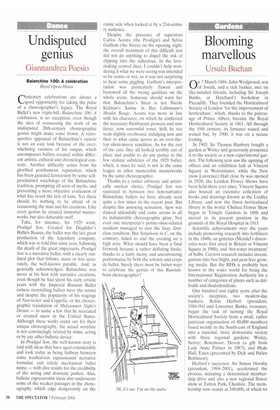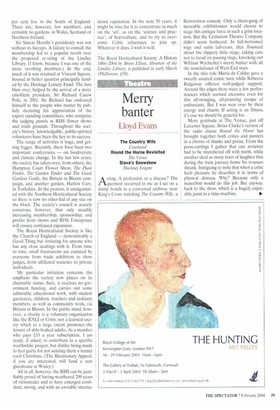Blooming marvellous
Ursula Buchan
On 7 March 1804, John Wedgwood, son of Josiah, and a rich banker, met six like-minded friends, including Sir Joseph Banks, at Hatchard's bookshop in Piccadilly. They founded the Horticultural Society of London 'for the improvement of horticulture', which, thanks to the patronage of Prince Albert, became the Royal Horticultural Society in 1861. All through the 19th century, its fortunes waxed and waned but, by 1900, it was on a secure footing.
In 1903, Sir Thomas Hanbury bought a garden at Wisley and generously presented it to the society as a new experimental garden. The following year saw the opening of offices and an exhibition hall at Vincent Square in Westminster, while the New (now Lawrence) Hall close by was opened in 1928; the London Flower Shows have been held there ever since. Vincent Square also housed an extensive collection of books and drawings known as the Lindley Library, and now the finest horticultural library in the world. Chelsea Flower Show began in Temple Gardens in 1888 and moved to its present position in the grounds of the Royal Hospital in 1913.
Scientific achievements over the years include pioneering research into fertilisers in the 1840s, on genetics (Mendel's discoveries were first aired in Britain at Vincent Square in 1900), and 'hot-water treatment' of bulbs. Current research includes investigations into box blight, and peat-free growing media. But the RHS is probably best known in the wider world for being the International Registration Authority for a number of categories of plants such as daffodils and rhododendrons.
One hundred and eighty years after the society's inception, two modern-day bankers, Robin Herbert (president, 1984-94) and Lawrence Banks, treasurer, began the task of turning the Royal Horticultural Society from a small, rather patrician organisation of 80,000 members based mainly in the South-east of England into a national, more democratic society with three regional gardens: Wisley, Surrey; Rosemoor, Devon (a gift from Lady Anne Palmer in 1987); and Hyde Hall, Essex (presented by Dick and Helen Robinson).
Herbert's successor, Sir Simon Hornby (president, 1994-2001), accelerated the process, initiating a determined membership drive and also a new regional flower show at Tatton Park, Cheshire. The membership now stands at 340,000, of which 64 per cent live in the South of England. There are, however, few members, and certainly no gardens, in Wales, Scotland or Northern Ireland.
Sir Simon Hornby's presidency was not without its hiccups. A failure to consult the membership led to a popular revolt over the proposed re-siting of the Lindley Library. (I know, because I was one of the more revolting members.) In the end, much of it was retained at Vincent Square, housed in better quarters principally funded by the Heritage Lottery Fund. The fuss blew over, helped by the arrival of a more emollient president, Sir Richard Carew Pole, in 2001. Sir Richard has endeared himself to the people who matter by publicly declaring his appreciation of the expert standing committees, who comprise the judging panels at RHS flower shows and trials grounds. Throughout the society's history, knowledgable, public-spirited volunteers have been the key to its success.
The range of activities is huge, and getting bigger. Recently, there have been two important conferences — on biodiversity and climate change. In the last few years, the society has taken over, from others, the Hampton Court Flower Show, The Plant Finder, The Garden Finder and The Good Gardens Guide, the Britain in Bloom campaign, and another garden, Harlow Carr, in Yorkshire. In the process, it amalgamated with the Northern Horticultural Society so there is now no other kid of any size on the block. The society's council is acutely conscious, however, that only steadily increasing membership, sponsorship, and profits from shows and RHS Enterprises will ensure continued expansion.
The Royal Horticultural Society is like the Church of England — demonstrably a Good Thing but irritating for anyone who has any close dealings with it. From time to time, small frustrations are endured by everyone from trade exhibitors to show judges, from affiliated societies to private My particular irritation concerns the emphasis the society now places on its charitable status. Sure, it receives no government funding, and carries out some admirable educational work, with student gardeners, children, teachers and ordinary members, as well as community work, via Britain in Bloom. In the public mind, however, a charity is a voluntary organisation like the RNLI or Crisis, not a learned society which to a large extent promotes the leisure of able-bodied adults. As a member who pays £33 a year subscription, I am ready, if asked, to contribute to a specific worthwhile project, but dislike being made to feel guilty for not sending them a tenner each Christmas. (The Bicentenary Appeal, if you are interested, will fund a new glasshouse at Wisley.)
All in all, however, the RHS can be justifiably proud of having weathered 200 years of vicissitudes and to have emerged confident, strong, and with an enviable interna
tional reputation. In the next 50 years, it might be wise for it to concentrate as much on the 'art', as on the 'science and practice', of horticulture, and to try to overcome Celtic reluctance to join up. Whatever it does, I wish it well.
The Royal Horticultural Society: A History 1804-2004 by Brent Elliott, librarian of the Lindley Library, is published in early March f50).



























































 Previous page
Previous page